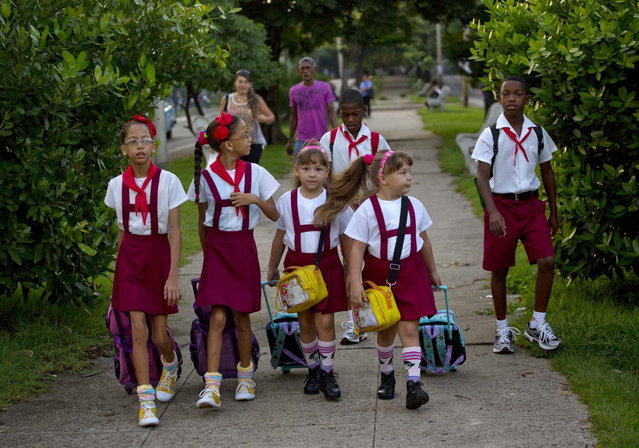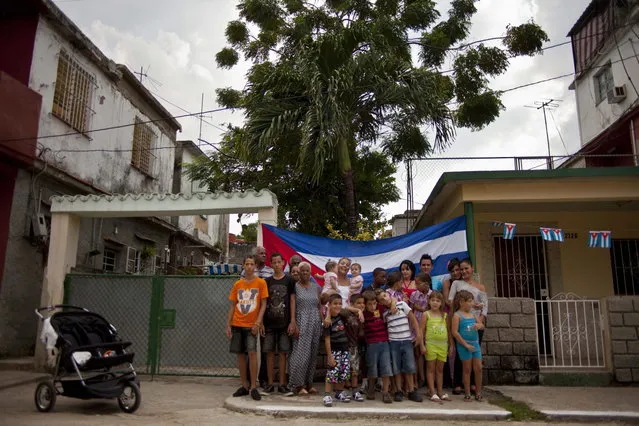“A street in the Cuban capital, Havana, is home to 12 sets of twins, ranging from toddlers to senior citizens. Some say it could be something in the water. Others point to a tree with mystical significance for locals. And maybe it's just chance.
Scientists say a variety of factors play into twin births, such as race, the mother's age and diet. Western Africa, from where many Afro-Cubans can trace their ancestry, has significantly elevated rates of twinning. Meanwhile statisticians caution against the human tendency to seek patterns of serendipity in a random world.
“Something could definitely be there, it could be a combination of various factors”, Andrew Gelman, a statistics professor at Columbia University, said via email. “In addition, opportunistic counting can make a small and natural pattern appear larger”. For example focusing on these two blocks without considering other surrounding ones, he added, “puts the spotlight on a small subset”.
While there's been no scholarly study of the twins on 68-A Street, they nonetheless consider themselves part of a special community. Some look to faith for an explanation. “There are neighbors who are religious. Many say it's the Siguaraya tree, which people ask for things and is in one of the homes”, Fe Fernandez said. “The people believe in it strongly”. Leafy and embellished with delicate white blossoms, the Siguaraya is considered sacred in the syncretic Afro-Cuban Santeria faith and is associated with a powerful “orisha”, or spirit.
Others, like Mercedes Montero, mother of 21-year-old Xavier and Lorena, chalk it up to the luck of the draw. “It's a very big coincidence”, Montero said, “one of those strange things in life”. – Andrea Rodriguez via Associated Press
Scientists say a variety of factors play into twin births, such as race, the mother's age and diet. Western Africa, from where many Afro-Cubans can trace their ancestry, has significantly elevated rates of twinning. Meanwhile statisticians caution against the human tendency to seek patterns of serendipity in a random world.
“Something could definitely be there, it could be a combination of various factors”, Andrew Gelman, a statistics professor at Columbia University, said via email. “In addition, opportunistic counting can make a small and natural pattern appear larger”. For example focusing on these two blocks without considering other surrounding ones, he added, “puts the spotlight on a small subset”.
While there's been no scholarly study of the twins on 68-A Street, they nonetheless consider themselves part of a special community. Some look to faith for an explanation. “There are neighbors who are religious. Many say it's the Siguaraya tree, which people ask for things and is in one of the homes”, Fe Fernandez said. “The people believe in it strongly”. Leafy and embellished with delicate white blossoms, the Siguaraya is considered sacred in the syncretic Afro-Cuban Santeria faith and is associated with a powerful “orisha”, or spirit.
Others, like Mercedes Montero, mother of 21-year-old Xavier and Lorena, chalk it up to the luck of the draw. “It's a very big coincidence”, Montero said, “one of those strange things in life”. – Andrea Rodriguez via Associated Press

In this September 23, 2013 photo, from left to right, nine-year-old twins Camila and Carla Rodriguez, and 18-year-old twins Kamar and Sahar Youssef holding six-year-old twins Asley and Aslen Velazquez, pose for portraits along their street where a poster of Fidel Castro hangs in Havana, Cuba. The twins are just some of the 12 sets of twins living along two consecutive blocks in western Havana. (Photo by Ramon Espinosa/AP Photo)

In this September 29, 2013 photo, 15-year-old twins Damian and Cosme Depersi pose for portraits in front a Cuban flag along their street in Havana, Cuba. The Depersi brothers are just one set of twins, out of 12 sets, living along two consecutive blocks in western Havana. (Photo by Ramon Espinosa/AP Photo)

In this September 29, 2013 photo, 65-year-old twin Fe Fernandez, left, and her sister Esperanza pose for a portrait in front a Cuban flag on their street in Havana, Cuba. Neighbors all marvel at the 12 sets of twins living along two consecutive blocks in western Havana, ranging in age from newborns to senior citizens. “We were the first ones”, said Fe Fernandez. (Photo by Ramon Espinosa/AP Photo)

In this September 23, 2013 photo, 11-year-old twin brothers Arian and Adrian Cueto pose for portraits in their school uniforms alongside their parents and grandfather as they gather around their family's truck in Havana, Cuba. The Cueto twins are one of 12 sets of twins living along two consecutive blocks in western Havana, ranging in age from newborns to senior citizens. (Photo by Ramon Espinosa/AP Photo)

In this September 23, 2013 photo, six-year-old twins Asley and Aslen Velazquez get ready for school in Havana, Cuba. Their mother Tamara said she never expected to have twins from her first pregnancy and did not take fertility treatments. “It's a lot of work. It requires a lot of patience,” Velazquez said. “They are very active and dominant, although each has a different character”. (Photo by Ramon Espinosa/AP Photo)

In this September 23, 2013 photo, from left to right, nine-year-old twins Camila and Carla Rodriguez, six-year-old twins Asley and Aslen Velazquez, and 11-year-old twin brothers Arian and Adrian Cueto walk together to school in Havana, Cuba. The twins are three sets of 12 living along two consecutive blocks in western Havana, ranging in age from newborns to senior citizens. (Photo by Ramon Espinosa/AP Photo)

In this September 29, 2013 photo, pairs of twins pose for a group portrait near a Siguaraya tree along their street in Havana, Cuba. While there's been no scholarly study of the twins on 68-A Street, some look to faith for an explanation. “Many say it's the Siguaraya tree, which people ask for things and is in one of the homes”, said Fe Fernandez, one of the twins. “The people believe in it strongly”. (Photo by Ramon Espinosa/AP Photo)

In this September 27, 2013 photo, Adrian Cueto, 11, center, embraces his father Ramon as his twin brother Arian looks on during interviews in Havana, Cuba. The Cueto brothers are just one set of twins out of 12 sets living along two consecutive blocks in western Havana. (Photo by Ramon Espinosa/AP Photo)

In this September 29, 2013 photo, six-year-old twins Asley and Aslen Velazquez hold eight-month-old twins Tiffani and Stessany Valles as they pose for portraits in front a Cuban flag on their street in Havana, Cuba. While there's been no scholarly study of the 12 sets of twins on 68-A Street, they nonetheless consider themselves part of a special community. (Photo by Ramon Espinosa/AP Photo)

In this September 29, 2013 photo, nine-year-old twin sisters Camila, left, and Carla Rodriguez pose for a portrait along their street in Havana, Cuba. 12 sets of twins live along two consecutive blocks in western Havana, ranging in age from newborns to senior citizens. “We love living on this block because we have twin friends”, said Carla. (Photo by Ramon Espinosa/AP Photo)

In this September 29, 2013 photo, twins Orlando Gonzalez, left, and Roberto Gonzalez pose for a portrait in front a Cuban flag along their street in Havana, Cuba. The Gonzalez brothers are one of 12 sets of twins living along two consecutive blocks in western Havana, ranging in age from newborns to senior citizens. (Photo by Ramon Espinosa/AP Photo)

In this September 23, 2013 photo, six-year-old twin sisters Asley and Aslen Velazquez prepare for school in Havana, Cuba. Their mother Tamara Velazquez said she never expected to have twins from her first pregnancy and did not take fertility treatments. “It's a lot of work. It requires a lot of patience”, Velazquez said. “They are very active and dominant, although each has a different character”. (Photo by Ramon Espinosa/AP Photo)
07 Oct 2013 06:44:00,
post received
0 comments
